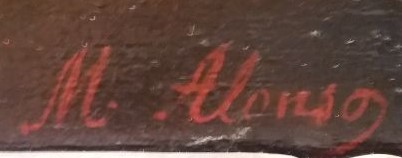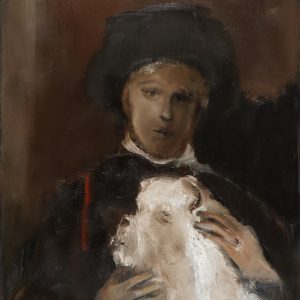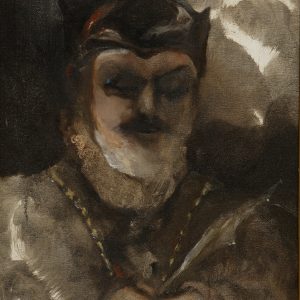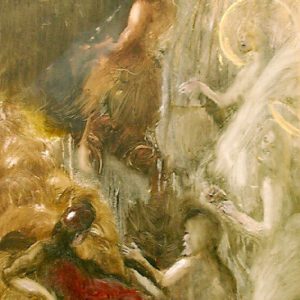Description
Artist/Maker: M. Alonso (signature lower right) after Diego Velázquez (painter/artist)
Object/Materials and Techniques: Oil painting/Oil on canvas, copy after one of Velázquez’s earlier masterpieces ‘The Triumph of Bacchus’, or the nickname ‘The Drunkards’/’Los Borrachos’
Date: Made on 19th century (estimate)
Dimensions: H. 96 cm. (estimate), W. 131 cm. (estimate)
Art movement: Style Baroque
Current Location: Private collection
Object history note: In private collection approximately for 70 years
Physical description: In a landscape, among a group of laughing peasants drinking (on the right), a young soldier (kneeling in the foreground) is being crowned by Bacchus, the god of wine in one of his rare depictions with pale skin, seated on a barrel, crowned with grape leaves and accompanied by satyrs (seated beside him on the left). It combines, thus, a mythological subject with a genre scene as the landscape could be any eating house and Bacchus any young man surrounded by his friends (bums and soldiers).
The painting is set in its original antique frame of ornate wood and plaster gilt finish.
Historical significance: This painting is a reduced copy of an artist by the name M. Alonso after Velázquez’s extremely important early work ‘The Triumph of Bacchus’, or ‘The Drunkards’ (165 x 225 cm.) dated 1628-1629 and currently held by the Museo del Prado, Madrid (P01170). The copy painted by M. Alonso constitutes a version of historical value due to the fact that it was most probably made inside the Royal Museum, as suggested by the Documentation Department of the Museum (still under investigation). After the opening of the Museo del Prado, fine arts students and painters were allowed to make copies of the paintings in the Museum rooms and were registered in the Royal Museum’s catalogues of visitors and copyists (currently in Museum’s archives).
Moreover, the painting of M. Alonso cannot be considered as a typical workshop copy due to its careful and thorough execution. Alike Velázquez’s original work, it is one of the few mythological scenes that deviates from previous depictions of a Dionysian feast, usually showing nymphs in green hills, in combination with a genre scene (the precise meaning of which is still subject to debate). It has been variously suggested that Velázquez’s scene represents a Flemish fête; a scene from the picaresque novel Vida y hechos de Estebanillo González; or abodegón (the Spanish term for Velázquez’s movement of a genre painting in a more naturalistic style, like everyday life). In Velázquez’s original painting notable is the use of colour, as he learned it from the work of Rübens and the 16thcentury Venetians, as well as his influence of Caravaggio’s techniques.
There is one more well known copy after Velásquez’s original painting in Victoria and Albert Museum in London (Museum number 336-1866 purchased): An oil painting [Height: 44.4 cm. (estimate), Width: 61 cm. (estimate)] painted by José Robles Martinez, probably made on 2nd half of 19th century, now in storage in V&A Museum. Descriptive line: Oil painting, ‘The Triumph of Bacchus, or the Drunkards’ copy by José Robles Martinez after Velázquez, late 19th century.
Historical context note: The famous Baroque Spanish painter Diego de Silvia y Velásquez (b. Seville 1599 d. Madrid 1660) lived, studied and created in Seville. As a young artist he was influenced by the Caravaggio style. In 1623 he became the official court painter of King Philip IV of Spain, in Madrid. There he had the opportunity to portray the royal family and its surroundings. At the Royal Court, in 1628, he met Rübens, who introduced him to the art of Titian. A characteristic feature of Velázquez’s art was to highlight the movement of light and the endless scale of its effects on form and colour. He searched the atmosphere between the viewer and the object. In his landscapes he was a naturalist, while in his portraits he was an obedient and objective observer, giving the society of his time historical respect. His produced mythological, religious and historical paintings, portraits and paintings of everyday life which were popular from the 17th century in Spain. Francisco Pacheco in his Arte de la pintura (1649) called the naturalistic genre scenes of Diego Velázquez bodegónes, from the name of a rough public eating-place (bodegón in Spanish means still-life).
Bibliographic References
- C.M. Kauffmann, Catalogue of Foreign Paintings, I. Before 1800, London, Victoria and Albert Museum, 1973, pp. 286-288, cat. no. 356.
- J.F. Riano, Catalogue of the art objects of Spanish production in the South Kensington Museum, 1872, p.70.
- J. Lopez-Rey, Velázquez, Koln, 1996, vol. II, cat. no. 41, p. 98-100.
- THE ART BOOK, PHAIDON, 1996, p. 473.
- MUSEO DEL PRADO, Ediciones Ocean S.A., Barcelona, 1992, ΤΖΙΑΜΠΙΡΗΣ-ΠΥΡΑΜΙΔΑ, 1994, p. 94, p. 131.

![M. Alonso - The Triumph Of Bacchus [19th century painting after Velázquez's 'The Triumph of Bacchus', or 'The Drunkards'/'Los Borrachos'] M. Alonso - The Triumph Of Bacchus [19th century painting after Velázquez's 'The Triumph of Bacchus', or 'The Drunkards'/'Los Borrachos']](https://storage.googleapis.com/n-art.org/2018/10/P1040290x1xB-1-scaled.jpg)

















